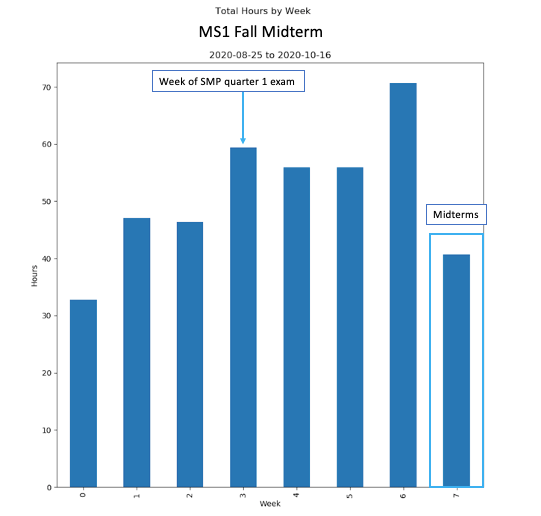Time Habits of a First-year Medical Student, Fall Midterm
It is official, I have made it through my first round of midterms as a medical student! Well, almost. I technically have one more exam to complete later this afternoon, but I have made a habit since undergrad of refusing to study past the point that I feel comfortable with the material. I have found that I end up getting too “into my head” if I continue to hit the books when I already know what I need to know to be successful on an exam. Interestingly, I have a history of writing before I take a final exam. So, as I use this time as a form of escapism from thinking about my impending histology exam, I analyzed the data I gathered regarding my study habits for the first 8 weeks of medical school.
Before I started classes this August, I took some time to think about how I could judge the efficiency and effectiveness of my study habits. I had recently learned some basic programming and wrote scripts that would allow me to track how I was using my time as a medical student. The first scripts (gCalTracking) utilize an IFTTT integration between Google Calendar and Google Sheets to record all of the events on my school affiliated calendar. I schedule all of my studying in blocks throughout each day, so the integration is able to capture my activity. Next, I wrote a Python script that would read the Google Sheet, parse the information, and spit out the duration, month, and day of the week for each event recorded in a new CSV file. I wrote another script in Jupyter Notebook to analyze the data from the new CSV file.
For the second script, (ManualTimeTracking) I created a Google form with categories of medical school-related activities. Each day, I filled out the form with the total amount of time I spent in each category. Every time I submitted the form, it created a new row in a Google sheet that I could analyze. I wrote a script in Jupyter Notebooks to read in the Google sheet and create data visualizations.
Creating two different methods for data collection allowed me to compare the two. The first script is useful in that it is more automated than the second. As long as my calendar has events on it, the data will be created in a new row in my Google Sheet. However, the first script does not allow me to differentiate between how I am using my time each day. For example, because the second script uses categorical data, I can slice the data to get a better understanding of how much time I spend in lectures versus using Anki.
Before I jump into the data, a word on definitions for the second script.
Class: Lectures, dedicated lab time, and exams
Anki: time studying flashcards (does not include making Anki notes)
Research: research meetings, data entry, paper writing
Self-study: any studying outside of Anki
Other: interest group meetings, shadowing, etc.
This data does not include travel time to or from class, nor study breaks throughout the day. My goal was to get an assessment of my time actually dedicated to the study of medicine.

This figure shows a categorical breakdown of my study time between 10/25/20 and 10/16/2020. You can see a ramp-up in studying beginning on 9/19/20 due to my SMP quarter 1 exam. You can also see a subsequent increase in weekend studying after the first quarter SMP exam (it was a wakeup call lol). There is also a slight uptick in daily time dedicated to Anki flashcards. Below is a more detailed look at my time spent using Anki leading up to Midterms.

The total time per day increased due to increased cumulative cards. I expect the total time to drop next week as I suspend notes not relevant to final exams and then the ramp-up will begin again.
Below are two figures showing a breakdown of my study time by the day of the week.


Wednesdays tend to be my busiest day due to ~5 hours of lecture per week. My time using Anki is generally the highest on Monday since I tend to add new Anatomy notes on Sunday evening and SMP/Histology notes on Monday morning. I have a standing 60-minute interest group meeting on Friday mornings. My weekends are not completely free but I do spend noticeably less time studying.

In general, I spent more time doing medical school-related activities each successive week of medical school. I attribute this to some classes not being formally introduced until a few weeks into the term and learning how to properly study for those classes. I actually spent less time on med school-related things during midterms week. This is in part because the data does not include the weekend and also because I scheduled breaks before and after exams to decompress (I have worked out more this week than any week of medical school).

Finally, I compared the data from ManualTime Tracking and gCal Tracking and found they are very similar (within 10% of one another) with gCal recording more study time than the manual method. I expected this since the gCal tracking method is not as specific (it cannot as easily account for breaks/dead time).
All in all, I dedicated about 400 hours to medical study in 8 weeks. I predict that the total will be higher in the next 8 weeks since I will have the opportunity to get more involved with extracurricular activities, volunteering, and research.
Find me
LinkedIn: https://www.linkedin.com/in/chris-hornung/
Twitter: https://twitter.com/ChrisHornung
Github: https://github.com/ChristyHorn14
